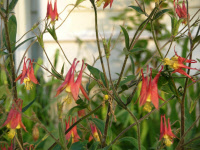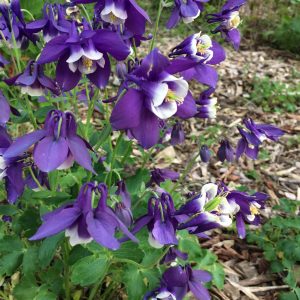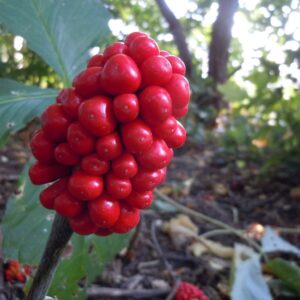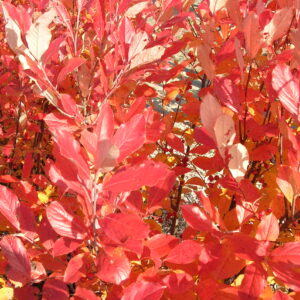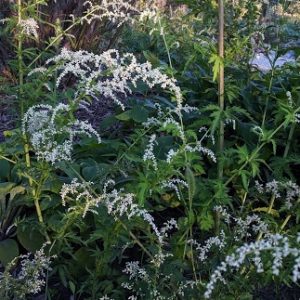Deer Resistant Plants
Showing 17–24 of 163 results
-
Aquilegia canadensis Canada Columbine Z 3-9
In May and June yellow petticoats peek out from under eye-popping red skirts flaring at the ends as these flowers dangle from tall stems.
In May and June yellow petticoats peek out from under eye-popping red skirts flaring at the ends as these flowers dangle from tall stems.
Size: 24-36”x 12”
Care: part shade in moist well-drained soil - moist in spring & dry in summer
Native: Eastern Canada to Florida, west to New Mexico, Wisconsin native.
Wildlife Value: Provides rich, early spring nectar for bumblebees, bees, butterflies, and hummingbirds. Buntings and finches eat seeds. Sole food source for Columbine duskywing caterpillar.
Awards: England’s Royal Horticultural Society Award of Merit.Seeds are fragrant when crushed, used by Omaha, Ponca and Pawnee as perfume. Pawnee used the plant as a love charm by rubbing pulverized seeds in palm of hand and endeavoring to shake hand of desired person. Crushed seeds also used to cure fever and headaches. Cherokee made a tea for heart trouble. The Iroquois used the plant to cure poisoning and to detect people who were bewitched. Grown by Tradescant the Elder in England in 1632. He may have received it from France. Cultivated by Washington & Jefferson. Grown at America’s 1st botanic garden, Elgin Botanic Garden 1811.
-
Aquilegia flabellata v. pumila syn. Aquilegia flabellata ‘Nana’, Aquilegia fauriei Dwarf Fan columbine Z 4-9
April-May lilac blooms of nodding lilac-blue to purple sepals with white petals on compact mound of blue-green foliage
OUT OF STOCK
April-May lilac blooms of nodding lilac-blue to purple sepals with white petals on compact mound of blue-green foliage
Size: 6-9” x 9-12”
Care: sun to part shade in moist well-drained soil, Deadhead for rebloom
Native: Japan
Wildlife Value: deer and rabbit resistant. Attracts butterfliesLatin word flabellatus mean fanlike referring to leaflet shape. First published as Aquilegia buergeriana var. pumila in Swiss journal Bulletin de l’Herbier Boissier 5: 1090. 1897.
-
Arisaema dracontium syn. Arum dracontium Green dragon, Dragon root Z 4-9 POISON
A greenish, long-tipped spadix (the "dragon’s tongue") grows several inches beyond a narrow green spathe, a narrow, greenish, hooded, cylinder. Numerous tiny flowers crowd onto the 6-inch-long flower stem. Tiny white flowers in spring turn into a spike of red berries in fall.
OUT OF STOCK
A greenish, long-tipped spadix (the “dragon’s tongue”) grows several inches beyond a narrow green spathe, a narrow, greenish, hooded, cylinder. Numerous tiny flowers crowd onto the 6-inch-long flower stem. Tiny white flowers in spring turn into a spike of red berries in fall.
Size: 1-3’ x 6-8”
Care: part-shade to shade in moist, slightly acidic soil
Native: NH to Florida, west to TX, north to MN. Wisconsin native
Wildlife Value: Deer resistant. Although poison to humans, birds, wild turkeys and wood thrush as well as some mammals eat the berries.Named by 1753. Arisaema, is Greek for “blood arum” or “red arum”. Dracontium, means “of the dragon” in Latin. Named for the resemblance of the spadix to the tongue of a dragon. For the Menominee sacred bundles of the roots and gave the owner the power of supernatural dreams.
-
Arisaema triphyllum Jack-in-the-pulpit, Indian turnip Z 4-9
May-June striped, hooded spathe (leaf-like bract shielding one side of the upright spike), red berries in fall
OUT OF STOCK
May-June striped, hooded spathe (leaf-like bract shielding one side of the upright spike), red berries in fall – a favorite shade plant
Size: 6-24”x 12”
Care: Part shade - shade in moist soil
Native: Eastern No. America, Wisconsin native.Pawnee medicine men pulverized the corm to treat headaches and rheumatism. The Cherokee used it to cure headaches, the common cold, ringworm, boils and “for scald head (and) scrofulous sores.” Iroquois remedied adolescent diarrhea and listless infants with Jack-in-the-pulpit. Also “for nonconception caused by cold blood” and for “temporary sterility.” Chopped root mixed with whiskey cured colds. It induced pregnancy for female horses. Menominee pulverized the root, placed in incised lip to counteract witchery on the face. The seed predicted death or recovery for the Meskwaki who also used it as poison to kill enemies. The Potawatomi discovered that cooking the root for 3 days eliminated the poison. HoChunk spread a compound of the root on neuralgia or rheumatism. Native Americans boiled the berries and roasted the root, for food. Garden cultivation since 1664.
**LISTED AS OUT OF STOCK BECAUSE WE DO NOT SHIP THIS ITEM. IT IS AVAILABLE FOR PURCHASE AT OUR RETAIL LOCATION.
-
Aronia arbutifolia Red chokeberry syn. Photinia pyrifolia SHRUB Z 5-9
Corymbs of white in spring, gorgeous red foliage in fall compliments the red berries that persist into winter
OUT OF STOCK
Corymbs of white in spring, gorgeous red foliage in fall compliments the red berries that persist into winter
Size: 6-8' X 3-5'
Care: sun to part shade in moist to well-drained acidic soil. Prune annually in late winter to promote vigorous growth.
Native: Nova Scotia west to Ontario south to TX & FL
Wildlife Value: Berries overwinter-food for Thrush, Oriole, and Cedar waxwings.Showy shrub collected by André Michaux around 1800. Aronia comes from aria a subgenus of a related plant, Sorbus. Arbutifolia means “leaves like the Arbutus.” William Robinson, father of mixed borders, reported: “Massed, charming both in flower and fine color of leaf in autumn.”
-
Artemisia frigida Prairie sagewort, Silky wormwood Z 3-10
Erect stems bear silvery-white, finely-divided foliage. Leaves smell like camphor. Inconspicuous yellow flowers bloom in summer.
OUT OF STOCK – EMAIL FOR AVAILABILITY
Erect stems bear silvery-white, finely-divided foliage. Leaves smell like camphor. Inconspicuous yellow flowers bloom in summer.
Size: 6-18” x 12-18”
Care: sun in well-drained soil. Drought tolerant.
Native: all North America except the SE, CA and OR, Wisconsin native
Wildlife Value: source of nesting material for native bees, food for caterpillars of several butterflies & moths
Awards: Royal Horticultural Society Award of Garden MeritNative Americans used this Artemisia to preserve meat, feed horses, repel insects, to remedy toothache, headache, coughing, lung ailments, heartburn, and colds. Indians in Great Basin used it in ceremonies. Chippewa made a decoction of root for convulsions. For the Lakota this was “women’s medicine” with an infusion helping regulate menstrual periods and induce contractions in pregnancy.
Meriwether Lewis collected this along the Missouri River in South Dakota on October 3, 1804. -
Artemisia lactiflora White mugwort Z 3-8
Plumes of creamy white, resembling an astilbe, above foliage blackish-green on one side and silver on the other side, Blooms August to October
OUT OF STOCK – EMAIL FOR AVAILABILITY
Blooms in plumes of creamy white, resembling an astilbe, above foliage blackish green on one side and silver on the other side. Blooms August to October.
Size: 4-5’ x 1.5-2’
Care: sun to part shade in moist, well-drained soil.
Native: East asia-China
Wildlife Value: attracts butterflies & bees. Rabbit and Deer tolerant
Awards: Royal Horticultural Society Award of Garden MeritGenus is named for Artemis, Greek goddess of the moon, wild animals, and hunting. Lactiflora means “milk-white flowers”
Used in traditional Chinese medicine to treat menstrual & liver disorders, and reduce inflammation. Southeast Asians cook with its leaves and tender stems boiled or stir fried and added to soups. 1st described in Western literature 1837.
-
Asarum canadense syn. Hexastylis canadense Wild ginger Z 3-7
Concealed brown bell-shaped flowers with flared tips hide under this groundcover's crinkled, lacquered leaves.
Concealed brown bell-shaped flowers with flared tips hide under this groundcover’s lacquered leaves.
Size: 6" x 6" spreading
Care: part shade to shade, moist well-drained to well-drained soil
Native: Canada to So. Carolina, Wisconsin nativeNative Americans used Wild ginger for such diverse purposes as flavoring food, curing heart palpitations, induce menstrual cycles, cure “the bite of the serpent,” mend broken bones, as a general tonic, a tea and lure catfish. Winnebago tenderized raccoon meat with this. Colonists used the plant to break fever and stimulate the appetite. Studies in the last 50 years have showed that the roots contain antibiotics BUT also can damage kidneys and are possibly carcinogenic.

